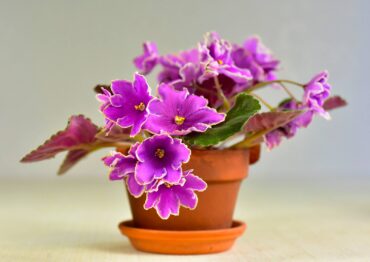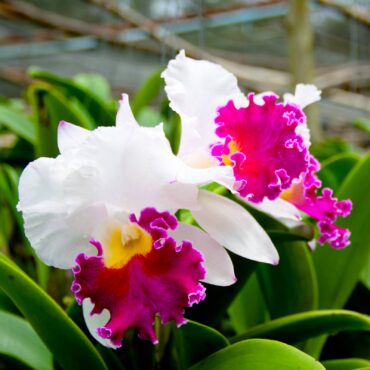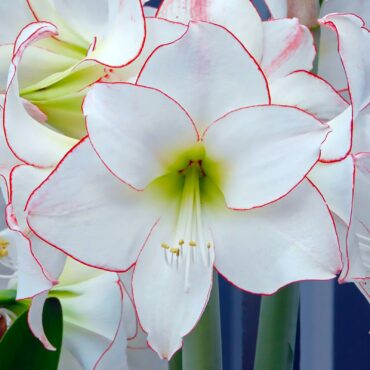Do you have the post-holiday blues? With the tinsel and decorations packed away, your home might feel a little bleak and bare. You need something pretty and festive to help endure gray, cold winter days. And as we count the weeks until the first crocus pops and the daffodils fill garden beds, what better mood-booster than brilliant winter-blooming houseplants?
Houseplants make a fabulous addition to indoor spaces. They add interest, create warmth and even help revive stale indoor air.
But when your gardener’s soul craves bursts of color, winter-flowering houseplants help alleviate the agony of endless dark days, waiting for spring garden season. Plus, wandering through a warm greenhouse as the snow swirls outside in search of a pretty plant is an instant mood booster.
Plan an outing to your local garden center and look for fabulous winter-blooming houseplants to add to your indoor space. Here are seven winter-blooming houseplants that can bring you some cheer on gray, chilly days.
 1. African Violet (Saintpaulia ionantha)
1. African Violet (Saintpaulia ionantha)
If your grandmother grew African violets and passed along her collection, lucky you! While these lovely houseplants originally hailed from eastern Africa, the multitude of hybrids available today for your indoor gardening pleasure surpasses 20,000 varieties.
From the classic blue blooms, we typically associate with African violets to white, pink, maroon, lavender, violet and deep purple flowers, today’s African violets create a brilliant rainbow as winter-blooming houseplants in your home.
You’ll also find bi-colored, two-tone, chimera, thumbprint, Geneva edge, speckled edge, colored edge, white center and raised edge flowers to add interest to your collection. And a collection it will become, because how can you resist these stunning plants? It’s like eating potato chips: You can’t stop with just one! Celebrate the Year of the African Violet — and start collecting them all.
How to Grow African Violets
Light: Filtered light, not full sun. Needs 14-16 hours of light and 8-10 hours of darkness daily to flower.
Soil: Well-drained soilless potting mix with a pH between 5.8 to 6.2 like a commercial African violet potting mix. Plant in a container with drainage holes and repot in fresh potting mix annually.
Water: Keep soil moist but not soggy. Use room-temperature, distilled water or rainwater and avoid softened or chlorinated water. Never let the plant sit in water, as it can develop root rot — one of the most common reasons African violets die.
Humidity: 40% to 60% humidity helps African violets thrive. Group plants together to conserve humidity or place the plant on a tray filled with pebbles and water, but make sure the plant doesn’t sit in the water.

2. Orchid (Orchidaceae)
With more than 28,000 species, orchids offer beautiful blooms to energize your interior throughout the year. As one of the largest flowering plant families, you will surely find an orchid to match your ideal aesthetic. Stately moth orchids, wispy, petite clusters of Dendrobium, colorful Cattleya, exotic-looking lady slippers — the options are endless.
If you’re looking for an orchid that blooms during winter months, however, try Cattleya orchids, like C. trianae and C. percivaliana (and many of its hybrids), early flowering Cymbidium species and hybrids, Coelogyne cristata, Lycaste skinneri (and many of its hybrids), Laelia superbiens (also known as Schomburgkia superbiens), Oncidium (also known as Trichocentrum cavendishianum), Phaius tankervilleae, Dendrobium mobile, and its hybrids, and Phalaenopsis species and hybrids — also commonly known as moth orchids, which might accidentally hop into your cart while you’re grocery shopping. Take a look here for more information about growing orchids. for your winter-blooming houseplants.
How to Grow Orchids
Light: 10-16 hours of bright, indirect light
Soil: Well-draining, lightweight potting mix specifically designed for orchids, such as bark and sphagnum moss, depending on the orchid species.
Water: Allow potting medium to dry out between waterings. Do not allow orchids to stand in water, which can cause root rot. Roots should appear plump and green or white, which indicates adequate moisture.
Humidity: Orchids thrive with 40% to 70% humidity. Place the pot on a tray filled with pebbles and water to increase humidity, but don’t allow the plant roots to sit in water.

3. Amaryllis (Hippeastrum)
Did you get busy during the holidays and forget to pot up your amaryllis bulbs? Well, that happy accident means you can now enjoy audacious, show-stopping blooms to cheer your winter days — just pop those forgotten bulbs in a pot, and before you know it, beautiful blooms will fill your home.
Or, if you forgot to order bulbs in the fall, you might find fantastic bargains on Amaryllis postholidays. Check your favorite bulb source or visit your local garden center to look for discounted bulbs.
These beauties produce multiple stalks with a series of blooms that can last a month or more. Plus, you really can’t find a more low-maintenance, easy-care plant that produces such glorious blooms. With more than 90 species and 600 cultivars, you’ll discover the perfect amaryllis to rid you of seasonal affective disorder. These beauties make the perfect distraction until the garden season arrives. Go here for an in-depth look at the many amaryllis varieties and how to care for them.
How to Grow Amaryllis
Light: Bright, indirect light for 12-16 hours daily. Too little light results in leggy growth.
Soil: High-quality potting mix that includes bark to promote draining.
Water: Water once when planting the bulb, then wait to water until you see signs of growth. Once the flower bud forms, begin watering when the top inch of soil feels dry to the touch. Do not allow the bulb to sit in soggy soil, as it can promote root rot.
Humidity: Tolerates low humidity.
4. Primrose (Primula)
With blooms so vibrant they’re almost gaudy, primrose flowers liven up even the dreariest winter days. These cheerful plants feature low rosettes of dark green leaves, outrageously colorful flowers and sturdy stalks. Some varieties produce clusters of flowers on a single stem, while others pop only one flower per stem.
You’ll find blooms in a wide range of colors and styles: pink, lavender, yellow, red, white, apricot, purple, bi-colored, single and double, and frilly. Adding a pretty pot of primroses is guaranteed to brighten your mood.
Choose plants with buds just about to open and place the plant in a cool location. Flowers last longest at 65 F and lower. Pinch back dead flowers to encourage repeat blooming. Keep these beauties looking their best by never allowing their roots to sit in water, which is a death sentence for primrose.
How to Grow Primrose
Light: Bright, indirect light for 12-16 hours a day. Keep out of direct sun, which can scorch the leaves and cause the plant to wilt.
Soil: Use well-draining soil, like African violet mix.
Water: Keep soil evenly moist, not soggy. The plants wilt quickly if the soil dries out.
Humidity: Prefer high humidity. Place the pot on a tray filled with pebbles and water to increase humidity, but don’t allow the roots to sit in water.
5. Anthurium (Anthurium spp.)
OK, we know. This flower-like spathe produced by anthurium isn’t actually a flower — it’s a modified leaf. (The tiny flowers are found on the red or yellow tail-like spike that emerges from the spathe.) But still — it is awfully pretty and looks like a bloom, so you should definitely add anthurium to your winter houseplant collection.
Plus, anthurium offers some of the greatest species diversity of any genus — from brilliant turtle-shell-like patterns of the crystal anthurium to dramatic slender leaves of the strap-leaf anthurium. You’ll love these unique, visually spectacular plants.
How to Grow Anthurium
Light: Bright, indirect light for 12-16 hours each day.
Soil: Use a well-draining soilless mix. Prefers an acidic pH.
Water: Keep soil slightly moist, never letting it completely dry out. Water when the top inch of soil feels dry.
Humidity: Prefers high humidity. Place the pot on a tray filled with pebbles and water to increase humidity, but don’t let the plant roots touch the water.
6. Begonia (Begonia spp.)
So many beautiful begonias, so little space. You could devote an entire bookshelf to these charming cuties. This fabulously diverse collection of plants typically is celebrated for its fantastic foliage — but the sweet blooms make an adorable addition to indoor displays, too.
From eyelash begonia to exotic, polka dot, mazae, rex and more, you’ll find the perfect plant to suit your personality. Not all begonias bloom in the winter, though. In fact, some enter dormancy.
Look for rhizomatous begonias, as most bloom during the winter, providing not only fabulous foliage, but pretty sprays of white or pink flowers in late winter as well. Also, look for Rieger begonias. Bred to bloom in winter and sold as disposable plants, these are a cross between standard wax begonias and tuberous begonias. Also known as elatior begonias, these plants may be marketed as disposable, but you can keep them thriving after they bloom. The pretty yellow, red, pink and white flowers will liven up your houseplant display.
How to Grow Begonias
Light: 12-16 hours of bright, indirect light.
Soil: Fast draining, light, airy potting mix.
Water: Let the top half inch of soil dry out between waterings. Don’t let the soil dry out completely.
Humidity: Prefers high humidity. Place the pot on a tray filled with pebbles and water to increase humidity. Don’t let roots sit in water.
7. Kalanchoe (Kalanchoe blossfeldiana sp.)
Although there are about 125 species of kalanchoe, the one you’ll most often find at the florist, garden center, and grocery store is Kalanchoe blossfeldiana. A pretty succulent that sports long-lasting, brilliant red, pink, orange or white blooms, it’s the ideal pick-me-up for dreary days.
While it’s an easy-to-grow plant, it does require some attention to encourage reblooming. Known as a short-day plant, it needs extended periods of complete darkness to form buds and bloom again.
When it has finished flowering, deadhead the plant’s blooms and place it in a spot where it will receive 14 hours of complete darkness each day for six to 11 weeks. Continue to water the plant as needed. Soon, you’ll enjoy a repeat floral show!
How to Grow Kalanchoe
Light: Bright, indirect light for 12-16 hours each day when flowering.
Soil: Well-draining succulent mix.
Water: Allow soil to dry out between waterings.
Humidity: Low.
Beginner tip: For indoor plants to bloom well, make sure they receive adequate light. While a space near a window may provide plenty of light, many houseplants dislike cold drafts that might creep inside, possibly harming delicate tropical foliage and flowers. If you feel a draft near windows, place your plant elsewhere and use a grow light instead.
Which winter-blooming houseplant will you pick to cheer you during chilly winter days? Why choose just one? Start a collection of winter-blooming houseplants. After all, spring is still far away, and you deserve to surround yourself with blooming beauties.
This article was adapted from a longer post originally published on the National Garden Bureau website. NGB provides these articles as an educational and inspirational service by its members. Founded more than 100 years ago, the organization educates, inspires and motivates people to grow home gardens. National Garden Bureau members are horticultural experts, and the information shared with you comes directly from these experts to ensure your gardening success.



























Comments